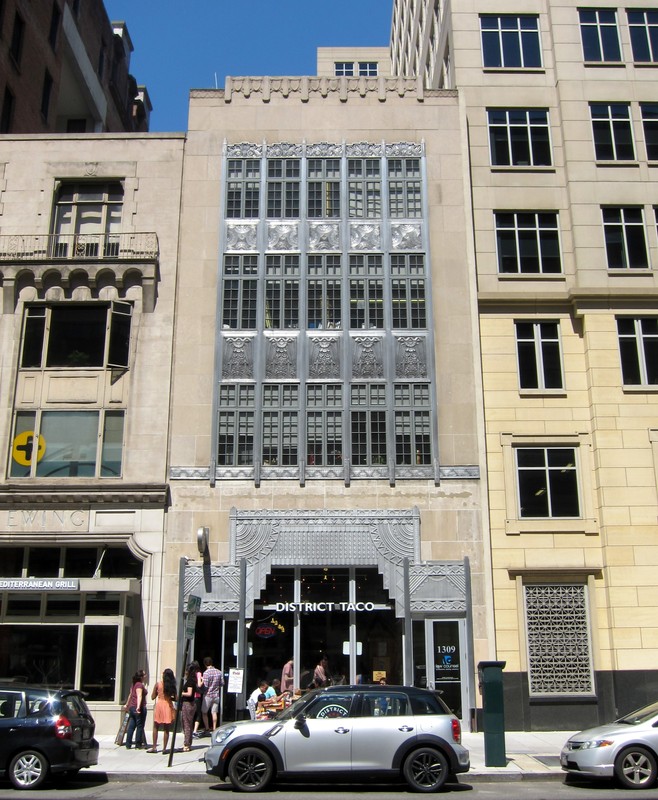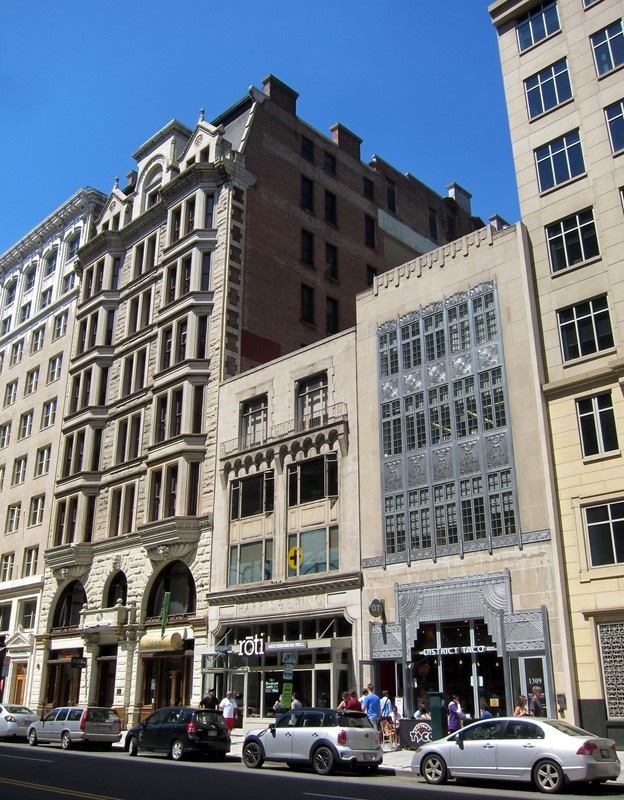Brownley Confectionary Building
Introduction
Text-to-speech Audio
The Brownley Confectionery Building is one of the few remaining Art Deco commercial buildings in what was once the city's most fashionable shopping district. Originally constructed in 1932 to house the Brownley family candy business, the structure is representative of the work by noted local architects Porter & Lockie. It is distinguished by the aluminum spandrel panels decorating its limestone facade. Though the confectionery closed 1940, the building is still in use today as restaurant and office space.
Images
The Brownley Confectionery Building located at 1309 F Street NW in downtown Washington, D.C. Image by AgnosticPreachersKid - Own work, CC BY-SA 4.0, https://commons.wikimedia.org/w/index.php?curid=39829967

(Right to left) Brownley Confectionery Building, Harris & Ewing Photographic Studio, and Sun Building. Image by AgnosticPreachersKid - Own work, CC BY-SA 4.0, https://commons.wikimedia.org/w/index.php?curid=39830507

Backstory and Context
Text-to-speech Audio
The Brownley Confectionary Building, located in the downtown area, is one of the few remaining Art Deco buildings in the District of Columbia. Designed by local architects Porter and Lockie (prominent during the interwar years), the four-story structure is distinguishable by the ornamentation on its facade. Porter & Lockie were pioneers of the Art Deco architectural style in Washington, D.C.. Other buildings by the firm include the Lutheran Church of the Reformation on
East Capitol Street NE and the Scottish Rite Temple in Columbia
Heights.
The building is a steel-framed concrete commercial row building with a brick and limestone exterior. Its rectangular footprint measures 26 feet in width and 83 feet in depth. The structure is capped with a flat metal roof. Except for the storefront on the first floor, the confectionery remains largely unchanged since its initial construction in 1932 by the James Baird Construction Company. The building, which cost approximately $60,000 during the height of the Great Depression, was one of the largest D.C. construction projects of the year.
The former candy store is distinguished by the Art Deco-style limestone and aluminum ornamentation on its front face. Art Deco, which was slow to gain acceptance in the capitol, is generally-recognized as having originated during the International Exposition of Modern Decorative and Industrial Arts held in Paris in 1925. The Brownley Building, with its zig-zagging aluminum panels and sunburst designs, represents one of the finest extant examples of this style in the D.C. area.
The Confectionery Building originally housed the Brownley family's candy business. The bottom floor housed a soda fountain and light lunch counter, and a rear balcony served as a lounge. The building was designed specifically as a candy store, with a kitchen and bake shop, and included such modern features as a fireproof design and air conditioning. Brownley's Confectionery closed in the 1940s, after which the space was utilized by various tenants, including Mayflower Donuts and Dash's mens clothing store. Added to the National Register of Historic Places on December 1, 1994, the structure is still in use today as restaurant and office space.
The building is a steel-framed concrete commercial row building with a brick and limestone exterior. Its rectangular footprint measures 26 feet in width and 83 feet in depth. The structure is capped with a flat metal roof. Except for the storefront on the first floor, the confectionery remains largely unchanged since its initial construction in 1932 by the James Baird Construction Company. The building, which cost approximately $60,000 during the height of the Great Depression, was one of the largest D.C. construction projects of the year.
The former candy store is distinguished by the Art Deco-style limestone and aluminum ornamentation on its front face. Art Deco, which was slow to gain acceptance in the capitol, is generally-recognized as having originated during the International Exposition of Modern Decorative and Industrial Arts held in Paris in 1925. The Brownley Building, with its zig-zagging aluminum panels and sunburst designs, represents one of the finest extant examples of this style in the D.C. area.
The Confectionery Building originally housed the Brownley family's candy business. The bottom floor housed a soda fountain and light lunch counter, and a rear balcony served as a lounge. The building was designed specifically as a candy store, with a kitchen and bake shop, and included such modern features as a fireproof design and air conditioning. Brownley's Confectionery closed in the 1940s, after which the space was utilized by various tenants, including Mayflower Donuts and Dash's mens clothing store. Added to the National Register of Historic Places on December 1, 1994, the structure is still in use today as restaurant and office space.
Sources
"Brownley Confectionary Building." DC Historic Sites. Accessed November 23, 2016. http://historicsites.dcpreservation.org/items/show/741.
Finn, Catherine. "Looking Back: Brownley Confectionery Building." dcist, January 2011. Accessed November 23, 2016. http://dcist.com/2011/01/looking_back_brownley_confectionery.php.
National Park Service. "National Register of Historic Places Nomination Form: Brownley Confectionery Building." November/December 1994. Accessed November 23, 2016. http://npgallery.nps.gov/pdfhost/docs/nrhp/text/94001408.PDF.
Finn, Catherine. "Looking Back: Brownley Confectionery Building." dcist, January 2011. Accessed November 23, 2016. http://dcist.com/2011/01/looking_back_brownley_confectionery.php.
National Park Service. "National Register of Historic Places Nomination Form: Brownley Confectionery Building." November/December 1994. Accessed November 23, 2016. http://npgallery.nps.gov/pdfhost/docs/nrhp/text/94001408.PDF.
